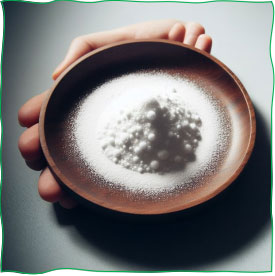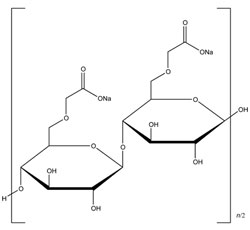Carboxymethyl Cellulose Calcium is known as Carmellose Calcium or Calcium CMC and is used in pharmaceutical formulations as an emulsifying agent; coating agent; stabilizing agent; suspending agent; tablet and capsule disintegrant; viscosity-increasing agent; water-absorbing agent.
In tablets : carboxymethylcellulose calcium used as a binder, diluent & disintegrant. In spite of its insolubility in water, it can imbibe water & swell many folds its original volume & thus proves an effective disintegrant. Upto 15% w/w of the material can be used, albeit hardness is reduced.
Oral & topical formulas : As a suspending & viscosity increasing agent. Wound dressings: Due its water absorbing & retention property it is used in hemostatic preparations.

Calcium Carboxymethyl Cellulose
Sample solution : Shake thoroughly 0.1 g of Carboxymethylcellulose Calcium with 10 mL of water, followed by 2 mL of 1 N sodium hydroxide, and allow to stand for 10 min.
[NOTE—Save unused portion of the Sample solution for use in Identification tests B & C.]
Analysis : To 1 mL of the Sample solution add water to make 5 mL. To 1 drop of the resulting solution, add 0.5 mL of chromotropic acid TS, and heat in a water bath for 10 min. A red-purple color develops.
Analysis : Shake 5 mL of the Sample solution prepared in Identification test A with 10 mL of acetone. A white, flocculent precipitate is obtained.
Analysis : Shake 5 mL of the Sample solution prepared in Identification test A with 1 mL of ferric chloride TS. A flocculent precipitate is obtained.
Analysis : Ignite 1 g to ash, dissolve the residue in 10 mL of water and 5 mL of 6 N acetic acid, and filter, if necessary. Boil the filtrate, cool, and neutralize with 6 N ammonia solution. Passes the test for calcium.

Inorganic Impurities
Residue on Ignition: 10.0%–20.0%; use 1.0 g of previously dried sample.
For Chloride :
Sample stock solution : Shake thoroughly 0.80 g with 50 mL of water, dissolve in 10 mL of 1 N NaOH & add water to make 100 mL. [NOTE—Retain a portion of the Sample stock solution for use in the test for Sulfate.]
Sample solution : Heat 20 mL of the Sample stock solution with 10 mL of 2 N nitric acid in a water bath until a flocculent precipitate is formed, cool, centrifuge, and remove the supernatant. Wash the precipitate with three 10-mL portions of water by centrifuging each time, combine the supernatant and the washings, add water to make 100 mL, and mix.
Limit : A 25-mL portion of the Sample solution shows no more chloride than is contained in 0.20 mL of 0.020 N hydrochloric acid (0.36%).
For Sulfate :
Sample solution : Heat 10 mL of the Sample stock solution prepared in the test for Chloride with 1 mL of HCl in a water bath until a flocculent precipitate is formed. Cool, centrifuge, and remove the supernatant. Wash the precipitate with three 10-mL portions of water by centrifuging each time, combine the supernatant and the washings, add water to make 100 mL, and mix.
Limit : A 25-mL portion of the Sample solution shows no more sulfate than is contained in 0.21 mL of 0.020 N sulfuric acid (1.0%).